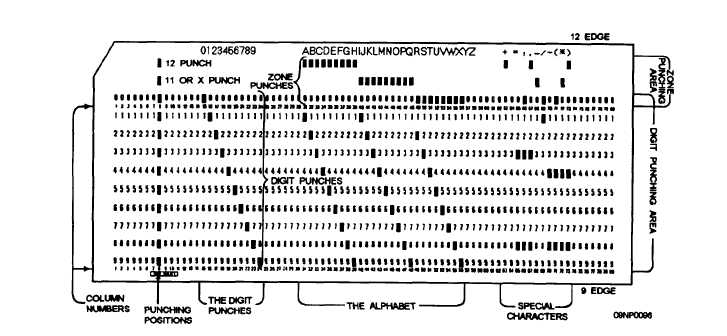| |
printed in many formats to provide blocks for entering
information by pen or typewriter that is later punched
into the card on the keypunch. It is not necessary for
you to learn the punch codes since most cards will be
“punched and interpreted.” That is, in addition to the
data punched into the card, the same information is
printed (interpreted) along the top of the card in one or
two lines. The character may be printed directly above
the punch or may be placed in any position depending
upon the machine being used.
Most cards have either the top left or top right
corner cut, although any corner may be cut. The card
in figure 11-2 has the left comer cut. This corner cut
provides a visual means to identify a type of card and
to make sure that all cards are facing in the same
direction and are right side up. It may also serve as a
signal to a machine as they are being processed.
To make effective use of the punched card, much of
the information is converted to codes. This is necessary
since the card contains only 80 columns. Only one
character can be placed in each column. In studying the
chapter on the Military Standard Requisitioning and
Issue Procedures (MILSTRIP), you saw how codes are
used to convey a great amount of information on the DD
Form 1348.
By converting the requisition information to a
keypunched card, it can then be used to reproduce other
cards for accounting, stock receipt, and requisition
status file. The supplying activity can use the punched
requisition to determine stock availability, prepare the
invoice, update stock records, and perform financial
accounting.
A punched card becomes a permanent record that
may be used for many purposes and used many times.
For this reason they should be handled with care since
a crease or rolled edge can jam a machine and delay a
job while a new card is prepared.
3-OF-9 BAR CODE
The 3-of-9 barcode is described in MIL-STD 1189,
Standard Symbology for Making Unit Packs, Outer
Containers, and Selected Documents. The code uses
various arrangements of 5 bars and 4 spaces (hence the
9) of which 3 are wide (the 3) to represent any of 43
different characters. The digits 0-9, the letters A-Z, 6
special characters (/. + % $), and a blank space can
be encoded by the 3-of-9. In addition to the barcode,
MIL-STD 1189 requires OCR-A characters to appear
above or below the bar codes. An example is shown in
figure 11-3.
This code is read by electronic devices called
scanners. These scanners have a hand held wand or
light pen that is passed over the 3-of-9 bar code, either
left to right or right to left. There are both stationary
and portable scanners available. These scanners are
very sensitive to the variations in the light and dark
areas. The bar code data element can be as long as 32
characters with a start/stop mark (an asterisk) and a clear
or blank space at both ends. The 3-of-9 bar code is
self-checking—it must contain an exact number of
Figure 11-2.-Example of a standard 80-column punched card.
11-2
|

